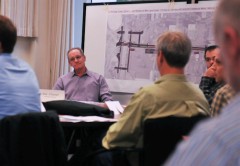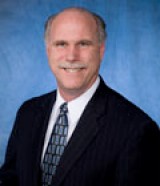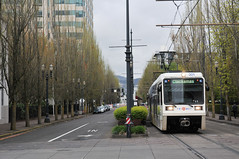
must have auto access on Holladay.
(Photo © J. Maus)
Efforts to improve bike access through the Lloyd District took yet another turn for the worse at a Stakeholder Advisory Committee meeting yesterday. Several influential business interests — including a representative of the Portland Development Commission (PDC) — expressed opposition motor vehicle access restrictions that many feel are key to turning NE Holladay Street into a low-stress bikeway.
Current proposals for Holladay that include various combinations of parking removal and auto closures in order to create a two-way bikeway have come under fire in recent weeks. On Tuesday, a project consultant with Alta Planning brought a new option to the table.
“As the representative of economic development agency of the City, I can’t support taking parking off. There’s redevelopment potential here… What I’m concerned about is getting more tax revenue to the City.”
— Irene Bowers, Portland Development Commission
Option 3 — which would have selected motor vehicle access restrictions, remove all parking except for eight spaces between NE 11th and 13th, and would require westbound bike traffic to use NE Multnomah — was met with criticism as well. But this time, the concerns came from committee members who felt it didn’t go far enough in creating a high quality bikeway.
As members expressed displeasure with the new option (which seems DOA at this point), member Justin Zeulner, who represents the Rose Garden/Rose Quarter and is President of the Association of Portland Neighborhood Business Associations, dropped a bombshell on the entire discussion:
“I see Holladay as such a narrow corridor that this feels like this has turned more into like a showcase project to me. That this is something we’d like to put on a map so we can show others what could be the future of alternative transportation… I’m wondering, are we just so down the rabbit hole that we’re afraid to say, O.K. what are we really effectively accomplishing with this project? … maybe we need to consider something else [a different street].”
Zeulner said he feels the committee should do an about-face and consider a different street instead. “I’ve spoken with some of the business entities… and there’s a lot of momentum to consider [NE] Multnomah.”
Committee member Lance Poehler disagreed with Zeulner, saying,
“Every time we get the chance to make something better the same kind of comments come up… and then nothing gets done… This is the one opportunity we’ve had to make an improvement in the Lloyd District and for us to throw that away because we might have a better Multnomah in the future, is ridiculous.”
Adding to the challenges on Holladay was committee member Mick O’Connell, who represents a developer who plans to build on the empty lot between NE 1st and 2nd (just north of the Convention Center). O’Connell said his firm has already gotten permits and “We’re depending on having vehicular access eastbound on Holladay.”
At that point, the project team (PBOT and Alta Consultants) decided a straw poll was needed to put to bed the idea of whether or not Holladay should remain the focus. A large majority voted in favor of Holladay (versus considering a different street altogether).

When the discussion turned back to the proposed parking removal, David Gragg, Senior Parking Manager for commercial real estate firm Ashforth Pacific and Chairman of the Lloyd Transportation Management Association (TMA), doubled down on his opposition.
“We still oppose removing any parking on Holladay,” he said. Gragg said his concern was lost revenue to the Lloyd TMA, which he characterized as “precarious at best.” (They’re so cash-strapped, Gragg says, his company loans them office space.) But as Gragg continued, it became clear that lost revenue (estimated at $13-$17,000 annually) wasn’t his only concern (emphasis mine):
“There are other impacts… When you look at development opportunity and you start taking these options away from developers, it does restrict the type of development that can happen. Ashforth is selling several properties and the new owner is excited about the development potential… As we start making these decisions [about parking], we start affecting long term plans for the short term benefit of a carefree bicycle ride for 14 blocks.”
Backing up the positions of Gragg and O’Connell was Irene Bowers, a senior project manager for the Portland Development Commission. (Bowers was at the meeting to share information on a “Green Street” project that she hopes will turn Holladay into a “showcase” for sustainability.):
“As the representative of economic development agency of the City, I can’t support taking parking off. There’s redevelopment potential here and I think we can all get along here. I think it’s possible to do it and keep the parking there.”
Committee Chair Harlow interjected,
“The engineers have told us that there isn’t capacity on Holladay for two-way cycle traffic with parking, which is what this project is about.”
To which Bowers replied,
“I think this project was to look at all different options, and there’s always the no-build option and there’s always different options, so you need to look at everything.”
In conclusion, Bowers re-stated her concerns,
“What I’m concerned about is getting more tax revenue to the City and the redevelopment of some of these empty blocks. If for whatever reason it [parking removal] precludes that, I would hate to have that happen.”
Looking for clarity from the committee on the parking issue and saying, “This is the first we’ve heard of this opposition [from the PDC],” project consultant Scott Bricker pushed for a straw poll on whether parking removal from Grand to NE 11th was supported. Eight members voted in favor of parking removal and three voted against it (Bowers, CH2MHill rep Rick Kuehn, and a rep from Ashforth Pacific).
I tracked down Bowers after the meeting to better understand her opposition. Bowers said some of the spots are used for long term parking and carpools and that, “Carpooling is just as valid as somebody riding a bike.”
Bowers maintains she’s not anti-bikeway, we just need to “Find a balance between all forms of transportation.”
So, is the PDC opposed to any parking being removed? Or perhaps just in certain sections? I asked. “Well, I hate to put it that way,” replied Bowers, “It’s not that black and white.”
“I’m not going to say that the PDC is opposed to it; but at this point in time, as a representative, I need to look at everything that’s occurring in the district; and when you look and see that there has already been parking displaced because of streetcar and then to ask this one district to take out even more… This may not be the right timing.”
What might the right timing be? “I have no idea, that’s hard to say” said Bowers.
Another issue for Bowers is that the Lloyd District is currently part of a PDC Urban Renewal Area. As such, Bowers said, they have a, “Fiduciary responsibility to raise property values within the district in order to pay back the bonds that have already been let.”
In the end, Bowers has to speak up for developers.
I’m hearing from the Rose Quarter and from Ashforth that [removing parking] may be a hindrance to redevelopment. So even if it’s true, or not true, or old perspectives, whatever — I can’t just discount what they have to say… Don’t make us out to be the bad guys.”
The PDC, the Central Eastside Industrial Council, Ashforth Pacific, the Rose Garden — these are heavy hitters in local politics whose influence reaches far into City Hall. As these projects get closer to decision points, it will be very interesting to see if PBOT is able to strike a compromise that meets the approval of the stakeholders and also stays true to the goals of the project.
Stay tuned.


